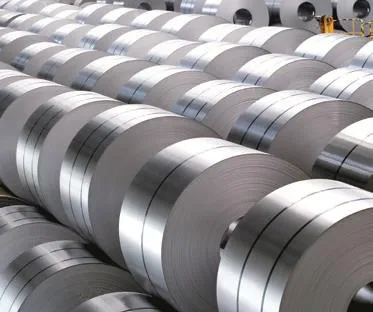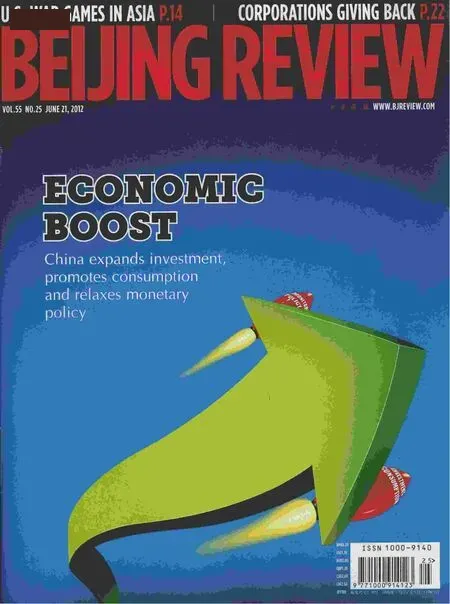At Excess Capacity
By Liu Xinlian
At Excess Capacity
By Liu Xinlian
China’s steel sector vows to face up to the problems created by rapid expansion
China’s steel blast furnaces are hot, too hot, operating at an overcapacity that will be exacerbated amid the economic slowdown.
The National Development and Reform Commission (NDRC) recently approved a mega steel project in Zhanjiang, Guangdong Province, and a plan by Wuhan Iron & Steel Group (Wusteel) to build a steel mill in Fangchenggang, Guangxi Zhuang Autonomous Region.
While local governments may be happy with the NDRC’s approval, the decision could worsen overcapacity in the already overcrowded industry.
Statistics show that China’s large and medium-sized steel enterprises suffered a defcit of 33.75 percent in the first four months of this year, with the total losses reaching more than 10.4 billion yuan ($1.64 billion), 32 times their losses during the same period of 2011.
Despite the fact that the country has repeatedly issued orders and regulations aimed at curbing blind expansion of domestic steel production, the market frenzy was still out of control. The sector pinned its hopes on industrial upgrading and consolidation to pull itself out of this predicament.
Slumping demand
With the domestic economy slowing and demand stagnant, Chinese steelmakers have kept their eyes on overseas markets. China’s steel exports jumped 28 percent in the first four months of this year.
But booming exports did not bring the profts that steelmakers need.
The steel industry realized 18.33 billion yuan ($2.91 billion) in proft in the frst quarter of this year, 67.8 percent less than in the same period of last year, according to NDRC data.
“The export surge in the steel sector was the result of price cut,” said Xie Zhaowei, an analyst with Huatai Great Wall Futures based in Guangzhou, Guangdong Province.
Steel prices in China have gone soft since last year. Last September, the China Iron Ore Price Index stood at around 600. Six months later it plunged to 480. During the same period, the Composite Steel Price Index decreased by more than 10 percent from 135 to 120.
“Domestic steel sector was plagued by its high reliance on overseas raw material. The world’s three top iron ore miners controlled the price, squeezing the whole sector’s proft margin,” said Chi Jingdong, Deputy Secretary General of China Iron and Steel Association (CISA).
Last year, the average CIF price of imported iron ore was $163.8 per ton, an increase of 28.1 percent from 2010, costing domestic steelmakers approximately $25 billion more in securing foreign ore.
Dropping prices come along with the country’s sluggish economy. As a barometer of the macroeconomy, China’s appetite for steel waned as the country’s GDP growth slowed down.
In the past decade, China’s demand for steel grew 15 percent annually, building the country into a powerhouse that now contributes more than 40 percent of global steel production. But last year steel demand was reduced by 8 percent and this year it could see a dramatic slowdown to 4 percent, according to CISA.
“It is not likely that the country will have big economic stimulus measures this year like that in 2008, so steel supply will outpace demand this whole year,” said Su Jiangang, President of Maanshan Iron and Steel Co. Ltd.
The growth in steel demand will be zero in the next few years, said Wu Wenzhang, General Manager of Steelhome.cn, a steel industry website based in Shanghai.
Blind expansion
When completed in 2015, the steel plant in Zhanjiang is expected to have an annual output of 10 million tons, more than 1 percent of the country’s total crude steel output last year. Wusteel’s Fangchenggang project is to have an annual capacity of 9.2 million tons.
But the output targets were set at a time when the sector is reporting grim performance and unprecedented overcapacity. CISA estimated that the industry could still produce in excess of 900 million tons this year, significantly above last year’s demand (domestic consumption plus exports) of a little less than 700 million tons.
The excess capacity remained an outstanding problem in the domestic steel in-dustry last year, according to a report released by the People’s Bank of China.

IRON GIANT: A worker at the Tangshan plant of Hebei Iron and Steel Group, China’s largest iron and steel maker in terms of output
The NDRC has repeatedly issued orders and regulations aimed at curbing the blind expansion of domestic steel production. In March 2009, a harsher-than-ever ban was even promulgated on the launching of any new steel projects within three years. In April 2010, the Chinese Government announced that small steelmakers, with steel blast furnaces smaller than 400 cubic meters, must shut down due to overcapacity concerns. But the glut of steel production continues to aggravate the Chinese economy.
The result released by the National Audit Office on June 1 showed that state-owned steel bigwigs, including Shanghai Baosteel Group (Baosteel), Anshan Iron and Steel Group (Angang) and Wusteel were found in violation of the ban on capacity limits.
“Despite the fact that the Chinese Government put steel in the shutdown list as early as 2005, its target has never been met in all these years. Steelmakers are still expanding their capacity,” said Huang Huiwen, an analyst with Shanghai CIFCO Futures.
“Only a small part of the new capacity was found and disclosed. Bigger parts in small and private steel mills were not able to be found,” said Huang.
China’s steelmakers are gambling that the Chinese economy will pick up again, said Pan Liang, a fnancial commentator.
In addition to overcapacity, the industry is still plagued by several structural problems such as low-end product mix, fragmented industry layout and large-scale outmoded facilities. Each year China needs to import more than 1 million tons of high-end stainless steel products from abroad, as there are only about 10 enterprises, out of more than 10,000 stainless steel manufacturers, that make high-end stainless steel products, said Jiang Zhenghua, Chairman of Jiangsu Sandeli Group, a domestic stainless steel pipe producer.
China should speed up eliminating outof-date capacity and developing high valueadded stainless steel products, instead of increasing capacity, as some local governments are doing, said Li Cheng, an advisor with the Stainless Steel Council of China Special Steel Enterprises Association.
Sector consolidation
The steel sector is in a crucial period oftransition highlighting low growth rate and low profit margin. According to the latest fiveyear plan for the steel industry, the sector will strictly control capacity expansion and speed up the elimination of outmoded capacity, continue to boost mergers and acquisitions for the creation of a more centralized industry and enhance product quality driven by innovation and technical updating.
China’s steel industry is expected to accelerate consolidation amid the grim market and sluggish demand, said Xu Xiangchun, chief analyst for Mysteel.com, a steel industry website based in Shanghai.
According to industry analysts, the approvals in the new steel plant follow a consistent policy in moving China’s industrial base away from heavily populated areas. The Central Government wanted to see more steel production transferred to the coast because of easier access to water, as well as more effcient logistics. The steel project of Wusteel in the coastal city of Fangchenggang is expected to help reduce the steelmaker’s transportation costs.
While giving the go-ahead to new steel mega projects in coastal areas, the government insisted that the approvals were part of the ongoing consolidation effort across the industry and that the new plant would replace the older, wasteful stock.
The NDRC said the Zhanjiang project is based on a sizeable cut in local steel production. It is expected that 16.14 million tons of crude steel production will be slashed in Guangdong Province.
Local authorities in Guangxi have agreed to cut capacity elsewhere as part of the deal involving the Fangchenggang project.
liuxinlian@bjreview.com

